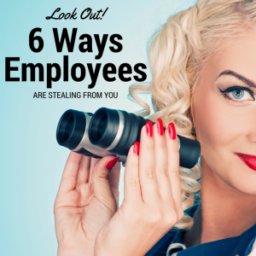Statistics have shown that restaurants, particularly those that open early and close late, are especially vulnerable to robberies…. and the number of incidents continues to rise.
This increased criminal activity is due to many factors applicable to the restaurant industry:
- -extended nighttime hours allow more time for robberies to be carried out under the cover of darkness
- -large amounts of accumulated cash kept on-site can be alluring
- -high rates of employee turnover can mean less extensive background checks
- -large staffs can lead to “friends helping friends” take advantage of less secure situations
- -set routines, day in and day out, help criminals plan their stealth moves for the least secure times
Are restaurants doing enough to enhance their security plan?
What can you do to increase security? There are several steps you can take to mitigate the possibility of a robbery at your place of business. Remember, a thief wants your money or your property and they want it fast! But they also want to get away with the crime, so whatever you can do to foul their plans will help protect your employees and your business.
Beef up your “late-night and early morning security menus!”
Here are some steps you can take to protect your restaurant from a robbery:
1.Secure opening and closing times.
Insist on the “buddy system” for opening and closing your restaurant. Law enforcement says this is one of the most important things you can do to curtail robberies at your place of business. There are specific security protocols for how one employee should open, unlock, enter, and check the premises while another employee stands ready to call for help should anything be amiss. Recommendation: Never schedule an employee to be alone in a restaurant at any time.
2. Follow established protocol for cash handling.
Keep cash on-hand to a minimum; don’t let cash accumulate in the cash drawer. Keep large bills in a time-controlled safe. Studies show that most robbers won’t wait around for twenty-minutes for a safe to unlock itself. This information, as well as your policy not to accept large bills, should be communicated to all employees and to the public. Combinations to safes should be changed regularly and especially when an employee entrusted with the access code is terminated. Don’t schedule bank trips at the same time each day. Your habits may be watched and assessed for a “robbery” opportunity. Recommendation: Change the route that the depositor takes to the bank each day and don’t have him/her carry a “cash bag” – use a container that is less obvious.
3. Know your employees.
Employee theft is the most frequent criminal activity in a restaurant. Deterring robberies at your restaurant starts during the employment screening process. Require references and then consistently conduct criminal background and reference checks. Restaurant employees are often nomadic and yet they are frequently allowed unlimited access to restaurant resources. This can be an open invitation to steal. Restaurants should have an honesty policy in place stating that any theft of money or resources is unacceptable. All employees should be required to sign the restaurant’s honesty policy, stating that they understand what actions are unacceptable and that they agree to comply with the policy. Recommendation: Assure applicants that lying on an application will not get them the job. When the word gets out about your background check follow-through, applicants with a criminal history of theft won’t bother to apply.
4. Schedule security training for employees.
Restaurant managers have lots of available resources to address security issues: crime-prevention videos, training session how-to’s, law enforcement presentations, security seminars, handouts, and take-home literature. Employees should be directed to never discuss sales volumes, disclose bank information, reveal alarm or safe codes, or divulge robbery prevention procedures with anyone. Reviews (quarterly, semi-annually, etc.) are vital to all employee continued training programs. Some restaurants report monitoring security issues “several times a day” to assure that security procedures are being followed. These reviews and follow-ups send positive security messages to employees, eliminating potential opportunities for would-be thieves. Recommendation: Regularly provide employee training that addresses the punishment for engaging in criminal activity, as well as the repercussions for “abetting” any criminal activity.
5. Enhance the security of your employees and your business.
There’s lots of other things you can do to protect both your employees and your premises. Some restaurants have invested in bulletproof drive-through windows, state-of-the-art digital video security cameras, and high-tech safes that can’t be opened by workers or robbers. Some businesses have installed silent alarm systems with activation buttons either located strategically throughout the building or on remote transmitters. Consider strategic video camera surveillance to include placing camera monitors near cash registers, in loading and receiving areas, near trash disposal areas, and beside exterior doors in full sight of customers. Always secure the back door; it should never be propped open. Recommendation: Install a peephole in the back door through which employees can view any and all activity in the rear of the restaurant and to prevent anyone from exiting the door blindly.
6. Scale up lighting and visibility.
Increase visibility both inside and outside the restaurant. Keep front doors and windows clear of signs or window writing that could impede employees from seeing suspicious persons outside. Landscaping should be well-maintained to allow for maximum visibility. Any foliage within four feet of walkways or doors should be no more than three feet high. Trees should hang no lower than six feet over the ground. Keep both the inside and the outside of your business well-lit at night for the safety of both employees and law enforcement. Exterior motion-detector lights are great impediments for those looking to engage in criminal activity during the nighttime hours. Recommendation: Install speed bumps in various places in your parking lot to discourage high speed getaways.
The key to robbery prevention is to continually assess current security procedures, as well as current environments within each restaurant location, then immediately make any needed adjustments.
About RLPSA
The Restaurant Loss Prevention and Security Association (RLPSA) is an exclusive community of loss prevention professionals focused on helping its members minimize losses and reduce liabilities within the restaurant and food industries.
We are industry leaders sharing our collective expertise, knowledge and solutions to the challenges we face every day. Our goal is to make our members more efficient and successful in their careers by serving as the “go-to” resource for restaurant and food industry loss prevention and security professionals.
As a member-run organization, we share information about industry trends and connect a network of peers who understand the unique challenges of the job, and who collaborate to find the next best solution. We create a forum for discussion and problem-solving so that our members benefit from shared expertise. We provide professional development opportunities that are designed to meet the specific interests and concerns of restaurant and food industry professionals, and we advocate for regulations that will make our workplaces more safe and secure.
For more resources, attend our annual conference. Visit: http://www.rlpsaannualconference.com/


